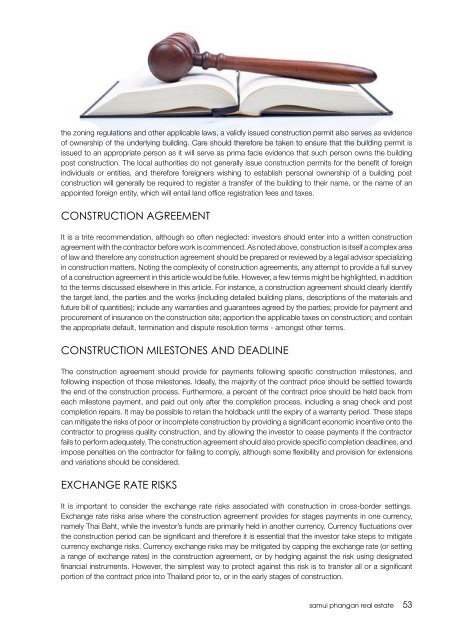Samui Phangan Real Estate Magazine October-November
Samui Phangan Real Estate Magazine Edition: October-November-2012 The definitive Guide to Samui Phangan Real Estate http://www.samui-phanganmagazine.com/
Samui Phangan Real Estate Magazine Edition: October-November-2012
The definitive Guide to Samui Phangan Real Estate
http://www.samui-phanganmagazine.com/
You also want an ePaper? Increase the reach of your titles
YUMPU automatically turns print PDFs into web optimized ePapers that Google loves.
the zoning regulations and other applicable laws, a validly issued construction permit also serves as evidence<br />
of ownership of the underlying building. Care should therefore be taken to ensure that the building permit is<br />
issued to an appropriate person as it will serve as prima facie evidence that such person owns the building<br />
post construction. The local authorities do not generally issue construction permits for the benefit of foreign<br />
individuals or entities, and therefore foreigners wishing to establish personal ownership of a building post<br />
construction will generally be required to register a transfer of the building to their name, or the name of an<br />
appointed foreign entity, which will entail land office registration fees and taxes.<br />
CONSTRUCTION AGREEMENT<br />
It is a trite recommendation, although so often neglected: investors should enter into a written construction<br />
agreement with the contractor before work is commenced. As noted above, construction is itself a complex area<br />
of law and therefore any construction agreement should be prepared or reviewed by a legal advisor specializing<br />
in construction matters. Noting the complexity of construction agreements, any attempt to provide a full survey<br />
of a construction agreement in this article would be futile. However, a few terms might be highlighted, in addition<br />
to the terms discussed elsewhere in this article. For instance, a construction agreement should clearly identify<br />
the target land, the parties and the works (including detailed building plans, descriptions of the materials and<br />
future bill of quantities); include any warranties and guarantees agreed by the parties; provide for payment and<br />
procurement of insurance on the construction site; apportion the applicable taxes on construction; and contain<br />
the appropriate default, termination and dispute resolution terms - amongst other terms.<br />
CONSTRUCTION MILESTONES AND DEADLINE<br />
The construction agreement should provide for payments following specific construction milestones, and<br />
following inspection of those milestones. Ideally, the majority of the contract price should be settled towards<br />
the end of the construction process. Furthermore, a percent of the contract price should be held back from<br />
each milestone payment, and paid out only after the completion process, including a snag check and post<br />
completion repairs. It may be possible to retain the holdback until the expiry of a warranty period. These steps<br />
can mitigate the risks of poor or incomplete construction by providing a significant economic incentive onto the<br />
contractor to progress quality construction, and by allowing the investor to cease payments if the contractor<br />
fails to perform adequately. The construction agreement should also provide specific completion deadlines, and<br />
impose penalties on the contractor for failing to comply, although some flexibility and provision for extensions<br />
and variations should be considered.<br />
ExCHANGE RATE RISKS<br />
It is important to consider the exchange rate risks associated with construction in cross-border settings.<br />
Exchange rate risks arise where the construction agreement provides for stages payments in one currency,<br />
namely Thai Baht, while the investor’s funds are primarily held in another currency. Currency fluctuations over<br />
the construction period can be significant and therefore it is essential that the investor take steps to mitigate<br />
currency exchange risks. Currency exchange risks may be mitigated by capping the exchange rate (or setting<br />
a range of exchange rates) in the construction agreement, or by hedging against the risk using designated<br />
financial instruments. However, the simplest way to protect against this risk is to transfer all or a significant<br />
portion of the contract price into Thailand prior to, or in the early stages of construction.<br />
samui phangan real estate 53





